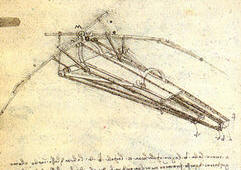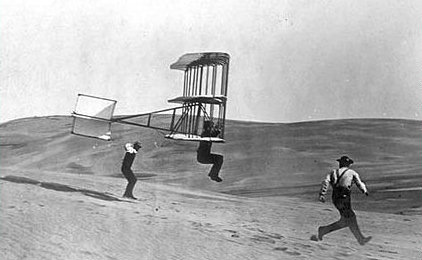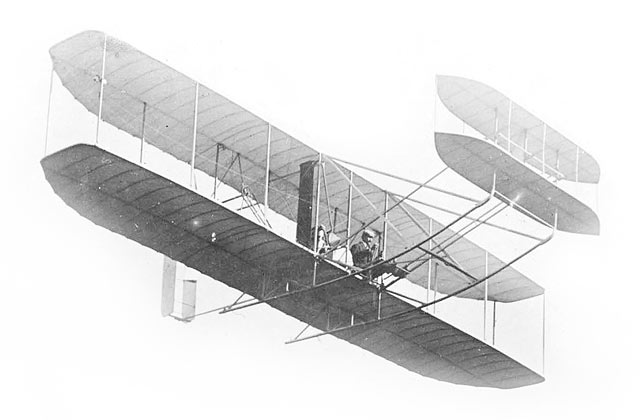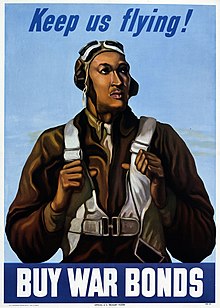
For ages, scientists and inventors have dreamed of airborne travel. Leonardo Da Vinci, renowned for his numerous accomplishments, is also widely recognized for his designs for human flight (right). Hot air balloons also provided an escape from the bounds of gravity, but were largely impractical for traveling with purpose. It was not until the 20th century, with the rapid increase in technological advances, that more practical methods of flight were invented.
 On December 17th, 1903, brothers Wilbur and Orville Wright completed the first sustained flight with a powered, controlled airplane. Choosing a location four miles south of Kitty Hawk, North Carolina, the Wright brothers's plane covered 852 feet in 59 seconds. The plane, known as the 1903 Flyer, was purely experimental in design. Not practical for flight, it laid the groundwork for the brothers's next project, the 1905 Flyer.
On December 17th, 1903, brothers Wilbur and Orville Wright completed the first sustained flight with a powered, controlled airplane. Choosing a location four miles south of Kitty Hawk, North Carolina, the Wright brothers's plane covered 852 feet in 59 seconds. The plane, known as the 1903 Flyer, was purely experimental in design. Not practical for flight, it laid the groundwork for the brothers's next project, the 1905 Flyer. The 1905 Flyer, though less well-known than its groundbreaking 1903 predecessor, was monumental in the process towards flight as a mode of transportation. The plane featured upright seating for a pilot and passenger, and was capable of flying for more than half an hour; more than 30 times the length of the 1903, 59-second flight. The plane also had greater endurance, and up to a 50% greater speed. Additional technological elements ensured that this prototype was the one carried forward with which increasingly complex planes were based upon.
The 1905 Flyer, though less well-known than its groundbreaking 1903 predecessor, was monumental in the process towards flight as a mode of transportation. The plane featured upright seating for a pilot and passenger, and was capable of flying for more than half an hour; more than 30 times the length of the 1903, 59-second flight. The plane also had greater endurance, and up to a 50% greater speed. Additional technological elements ensured that this prototype was the one carried forward with which increasingly complex planes were based upon. 9 years later, World War I demonstrated just how far airplanes had come since 1903. Initially used solely for reconnaissance (surveying an enemy's territory), the stalemate nature of trench warfare ensured that the nation with the strongest force in the air would make the most military gains. This led to numerous advances in flight technology, innovations that would allow pilots to fly their crafts higher, faster, and with greater maneuverability. In addition to these technological advances, the intense use of aircrafts during combat laid the foundation for warfare in the rest of the 20th century; war that increasingly relied on the power of a nation's air force and technological prowess to maintain such an air force.
9 years later, World War I demonstrated just how far airplanes had come since 1903. Initially used solely for reconnaissance (surveying an enemy's territory), the stalemate nature of trench warfare ensured that the nation with the strongest force in the air would make the most military gains. This led to numerous advances in flight technology, innovations that would allow pilots to fly their crafts higher, faster, and with greater maneuverability. In addition to these technological advances, the intense use of aircrafts during combat laid the foundation for warfare in the rest of the 20th century; war that increasingly relied on the power of a nation's air force and technological prowess to maintain such an air force.The time between the two World Wars is often referred to as the "Golden Age of Aeronautics" due to the overarching advances that were made during these years; others refer to the Golden Age as having started with Charles Lindbergh's trans-Atlantic flight in 1927. At the start of WWI, airplanes were simplistic enough that pilots could fly - and were sent into combat - with only several hours of flight training. By the start of WWII 20 years later, planes had transformed from "slow, wood and wire-framed and fabric-covered biplanes to fast, sleek, all-metal monoplanes" (http://www.allstar.fiu.edu/aero/wings4.htm).
 In the several years after WWI, not only were new achievements for the planes themselves, but also for the people flying them. Amelia Earhart, born 1897, was setting world records in flight by 1922 when she became the first woman to reach an altitude of 14,000 feet. But her largest, most arduous accomplishments were yet to come; solo flights across the Atlantic, from Honolulu to Oakland, and several more traversing the North American continent. Of her achievements, Earhart said they "proved men and women were equal in 'jobs requiring intelligence, coordination, speed, coolness, and willpower' " (http://www.ameliaearhart.com/about/bio.html). Earhart's final flight was made during her attempt to set the record as the first woman to fly around the world; attempting to land on a remote island in the Pacific, she and her navigator were never heard from again. Earhart's accomplishments were groundbreaking in both the skill required, and in the precedent she set for women, especially during that time period, and she is remembered fondly for both.
In the several years after WWI, not only were new achievements for the planes themselves, but also for the people flying them. Amelia Earhart, born 1897, was setting world records in flight by 1922 when she became the first woman to reach an altitude of 14,000 feet. But her largest, most arduous accomplishments were yet to come; solo flights across the Atlantic, from Honolulu to Oakland, and several more traversing the North American continent. Of her achievements, Earhart said they "proved men and women were equal in 'jobs requiring intelligence, coordination, speed, coolness, and willpower' " (http://www.ameliaearhart.com/about/bio.html). Earhart's final flight was made during her attempt to set the record as the first woman to fly around the world; attempting to land on a remote island in the Pacific, she and her navigator were never heard from again. Earhart's accomplishments were groundbreaking in both the skill required, and in the precedent she set for women, especially during that time period, and she is remembered fondly for both. With the start of World War II, airplanes had defined themselves as a vital part of warfare. This war, truly on a global scale and fought in both the Atlantic and Pacific oceans, required more airpower, both for transportation of soldiers and weaponry, and for combat. The infamous firebombing of Tokyo and the equally as infamous bombing of Dresden were carried out using the new aircraft technology. Japan's Kamikaze pilots also garnered a reputation as fearless - and insane - fliers during the war.
With the start of World War II, airplanes had defined themselves as a vital part of warfare. This war, truly on a global scale and fought in both the Atlantic and Pacific oceans, required more airpower, both for transportation of soldiers and weaponry, and for combat. The infamous firebombing of Tokyo and the equally as infamous bombing of Dresden were carried out using the new aircraft technology. Japan's Kamikaze pilots also garnered a reputation as fearless - and insane - fliers during the war. One of the most famed groups of pilots during World War II were the Tuskegee Airmen (formally the 332nd Fighter Group and the 477th Bombardment Group of the US Air Force). The United States still had segregation laws at the time of the war, and the military was subject to these as well. The Tuskegee Airmen, the first African-American aviators in the US, were the victims of racism within society, and the military, while still bravely serving the country that hated their race - an irony that has been pointed out countless times in countless situations in order for marginalized groups to gain rights. The Tuskegee Airmen were renowned for their aviation skill, and again, their willingness to serve regardless of the racism they faced. Like Amelia Earhart, the Tuskegee Airmen set records for skill, and for breaking down barriers as to who could fly.
One of the most famed groups of pilots during World War II were the Tuskegee Airmen (formally the 332nd Fighter Group and the 477th Bombardment Group of the US Air Force). The United States still had segregation laws at the time of the war, and the military was subject to these as well. The Tuskegee Airmen, the first African-American aviators in the US, were the victims of racism within society, and the military, while still bravely serving the country that hated their race - an irony that has been pointed out countless times in countless situations in order for marginalized groups to gain rights. The Tuskegee Airmen were renowned for their aviation skill, and again, their willingness to serve regardless of the racism they faced. Like Amelia Earhart, the Tuskegee Airmen set records for skill, and for breaking down barriers as to who could fly. Commercial flight, which had been available but enormously expensive, became a much more popular option post-WWII. The excess of military aviation technology was converted into passenger crafts, making at least the technology more accessible to everyday people. By 1950, trans-Atlantic flights - just like the ones that Lindbergh and Earhart had made history flying - were the most traveled in the world. No doubt this made communications between nations easier, adding to the globalization of world politics and economy, but it also shrunk the world for people. Vacationing in far-flung places was now an option, if still only for the rich right now.
Commercial flight, which had been available but enormously expensive, became a much more popular option post-WWII. The excess of military aviation technology was converted into passenger crafts, making at least the technology more accessible to everyday people. By 1950, trans-Atlantic flights - just like the ones that Lindbergh and Earhart had made history flying - were the most traveled in the world. No doubt this made communications between nations easier, adding to the globalization of world politics and economy, but it also shrunk the world for people. Vacationing in far-flung places was now an option, if still only for the rich right now. At left is a map showing the world's scheduled commercial airline traffic in 2009. With flights so much more accessible than they were just half a century earlier, the vast majority of the population of the developed world has traveled on at least one airplane. Not only has the technology advanced exponentially since Wilbur and Orville's first flights in Kitty Hawk, but the globalization facilitated by the technology has been revolutionary. Politics, economics, the environment, and societies have been transformed as a result of the increased travel, and these will likely continue to evolve in change throughout the 21st century and beyond.
At left is a map showing the world's scheduled commercial airline traffic in 2009. With flights so much more accessible than they were just half a century earlier, the vast majority of the population of the developed world has traveled on at least one airplane. Not only has the technology advanced exponentially since Wilbur and Orville's first flights in Kitty Hawk, but the globalization facilitated by the technology has been revolutionary. Politics, economics, the environment, and societies have been transformed as a result of the increased travel, and these will likely continue to evolve in change throughout the 21st century and beyond.
Sources
1. http://www.wright-brothers.org/History_Wing/History_of_the_Airplane/History_of_the_Airplane_Intro/History_of_the_Airplane_Intro.htm
2. http://www.wright-brothers.org/History_Wing/History_of_the_Airplane/Doers_and_Dreamers/Doers_and_Dreamers_images/
Herring/Herring_in_Chanute_Oscillating_Wing_Glider_1902.jpg
Herring/Herring_in_Chanute_Oscillating_Wing_Glider_1902.jpg
3. https://www.asme.org/wwwasmeorg/media/ASMEMedia/About%20ASME/WhoWeAre/History/Landmarks/224-Wright-Flyer-III_01.jpg
4. https://historyclass2012.wikispaces.com/file/view/029761.jpg/163869823/029761.jpg
5. http://thumbs.media.smithsonianmag.com//filer/age-388-mar04.jpg__800x600_q85_crop.jpg
6. http://www.scholastic.com/content/images/articles/sn_ts/sn_ts_122210_hdr.jpg
7. http://i.imgur.com/yJdAR.jpg
8. https://en.wikipedia.org/wiki/Tuskegee_Airmen
9. http://www.burnsmcd.com/insightsnews/insights/aviation-special-report/2011/timeline-of-commercial-aviation
10. https://en.wikipedia.org/wiki/Commercial_aviation#Postwar_aviation
http://www.airspacemag.com/history-of-flight/airplanes-that-transformed-aviation-46502830/?no-ist
http://www.allstar.fiu.edu/aero/wings4.htm
http://www.ameliaearhart.com/about/bio.html

No comments:
Post a Comment